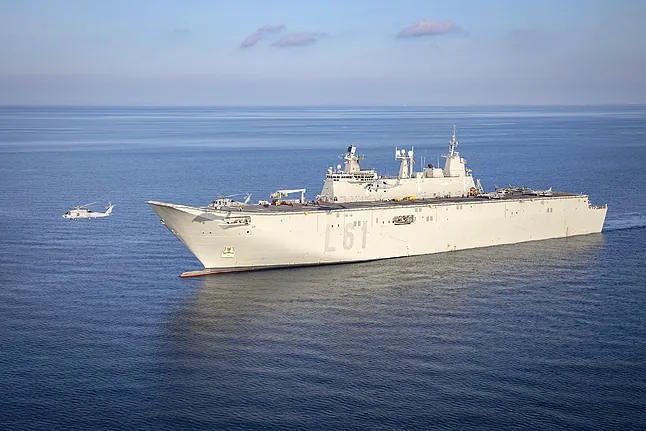The Navantia shipyard is working on a feasibility study to build a conventional aircraft carrier for the Spanish Navy. This type of ship will allow planes to take off and land by rolling on the runway, a capability that Spanish aircraft carriers have not had until now, as they had to land vertically, which conditioned and limited the type of planes that could be acquired. Until now, the only fighters Spain could acquire were the Harriers, whose service life will end in 2028.
As confirmed by EL MUNDO, the preliminary study, which will take up to two years to materialize, is specifying the characteristics of a ship that will be larger than the current Juan Carlos I LHD, the only active aircraft carrier in the Navy and will be able to carry up to 30 aircraft, like other European navy ships such as the French Charles de Gaulle.
This step opens up new possibilities for the Spanish Navy, as until now its aircraft carriers depended on the American company Lockheed Martin. This company also manufactures the F-35 fighters, which are expected to be the natural replacement for the Harrier AV8. However, disagreements between the Spanish and American governments, motivated by Spain's reluctance towards the American industry, have led to a lack of agreement to acquire this fighter. According to sources consulted, however, in its most current version, the F-35 seems to be one of the aircraft with the most potential. There are already 16 armies using the F-35, including the United Kingdom, Italy, Belgium, and Germany. Spain needs to acquire 12 fighters with the option for six more.
A 'made in Spain' aircraft carrier increases the capabilities for the Spanish Defense industry, as well as the strength of the Navy. For months, they have been actively working to be prepared for future capabilities. In a changing world, they are striving to keep up with a horizon: the year 2050. A few months ago, the Chief of Naval Staff, Admiral Piñeiro, presented the program to the press, and this Wednesday, at the General Headquarters, Infodefensa presented the publication Profiles where, for the first time, the 37 ships that the Navy has ordered to meet its objectives are listed.
This document sets the objectives to remain operational on and from the sea. Maintaining deterrence capabilities thanks to a powerful amphibious landing force that defends national sovereignty, as well as working in a digital and multidomain battlefield. The Navy, whose list of capabilities also responds to those accepted by Sánchez from NATO, estimates that in the short term, they will receive or modernize 37 ships.
The most immediate event will take place on July 21, when the second submarine of the S-80 class, the S-82 Narciso Monturiol, touches the sea in a ceremony where the wife of the Chief of Defense Staff will be the godmother. Spain has committed to four of these submarines, which, if the deadlines are met after an initial delay of a year and a half, will be delivered between 2028 and 2030.
In addition to technical capabilities, the Navy will need more personnel in the coming years. The three armed forces foresee an increase of 7,500 soldiers by 2030, of which just over a thousand will be for the Navy. However, they are aware that retaining talent, especially in the fields of electronic warfare and cybersecurity, is a challenge. For all the ships that are planned to be acquired, and that are already approved, more personnel will be needed.
In addition to the four pending submarines to be delivered, the Navy is working to acquire a Submarine Intervention Vessel that will be received in 2026 and increase by two the maritime action ships (it currently has six). Furthermore, in April 2028, a new F-110 from the modernization program will be delivered, which includes five new frigates of this type, as well as the modernization of the other five frigates that the Navy already has. Despite the spectacle of an aircraft carrier, the F-110s are technologically more advanced ships that require more personnel to operate. two new maritime action ships.
Starting in 2030, Spain will also incorporate six European patrol corvettes to replace the four Serviola-class offshore patrol vessels. These ships will have defense capabilities above and below the water and will serve as second-line escorts behind the F-110s.
This modernization also includes the acquisition of two Coastal Hydrographic Vessels and an Oceanic Hydrographic Vessel, as well as the adaptation of the six minesweepers of the Segura class. The amphibious assault ships Castilla and Galicia will also be modernized to include, among other things, improvements in their combat systems. Additionally, the Council of Ministers approved an investment of 703 million euros in the modernization of the Combat Supply Ship, as well as a naval platform to replace the Alerta ship. Both programs are part of the Industrial and Technological Plan presented by Sánchez.
